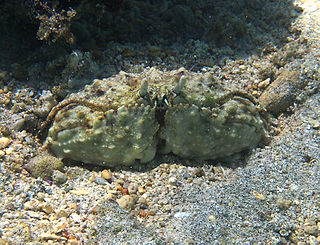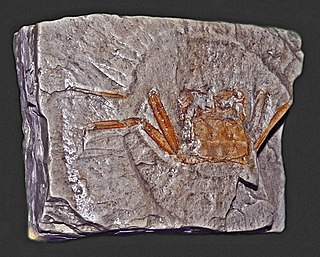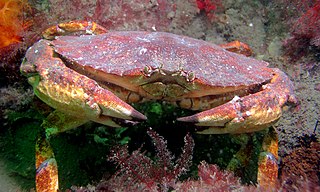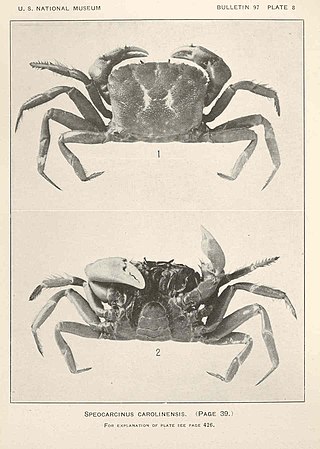
Cancer pagurus, commonly known as the edible crab or brown crab, is a species of crab found in the North Sea, North Atlantic Ocean, and perhaps the Mediterranean Sea. It is a robust crab of a reddish-brown colour, having an oval carapace with a characteristic "pie crust" edge and black tips to the claws. A mature adult may have a carapace width up to 25 centimetres and weigh up to 3 kilograms. C. pagurus is a nocturnal predator, targeting a range of molluscs and crustaceans. It is the subject of the largest crab fishery in Western Europe, centred on the coasts of the Ireland and Britain, with more than 60,000 tonnes caught annually.

Calappa is a genus of crabs known commonly as box crabs or shame-faced crabs. The name box crab comes from their distinctly bulky carapace, and the name shame-faced is from anthropomorphising the way the crab's chelae (claws) fold up and cover its face, as if it were hiding its face in shame.

Metacarcinus anthonyi, the yellow rock crab or yellow crab, is a species of edible crab native to the Pacific coast of North America.

The pie crust crab, is a species of crab found around New Zealand and south-eastern Australia.

Cancridae is a family of crabs. It comprises six extant genera, and ten exclusively fossil genera, in two subfamilies:

Portunoidea is a superfamily of crabs that includes the family Portunidae, the swimming crabs. Which other crab families are also placed here is a matter of some contention, and may be revised following molecular phylogenetic analyses.

Retroplumidae is a family of heterotrematan crabs, placed in their own (monotypic) superfamily, Retroplumoidea.

Cancer productus, one of several species known as red rock crabs, is a crab of the genus Cancer found on the western coast of North America. This species is commonly nicknamed the Pearl of the Pacific Northwest.
Metacarcinus starri is an extinct species of crab in the family Cancridae, subfamily Cancrinae. The species is known solely from the early Miocene, Clallam Formation and the underlying Pysht Formation deposits on the Olympic Peninsula of Washington state, United States.

Goneplacidae is a family of crabs of the order Decapoda and the superfamily Goneplacoidea. It includes the following genera:

Hexapodidae is a family of crabs, the only family in the superfamily Hexapodoidea. It has traditionally been treated as a subfamily of the family Goneplacidae, and was originally described as a subfamily of Pinnotheridae. Its members can be distinguished from all other true crabs by the reduction of the thorax, such that only seven sternites are exposed, and only four pairs of pereiopods are present. Not counting the enlarged pair of claws, this leaves only six walking legs, from which the type genus Hexapus, and therefore the whole family, takes its name. Some anomuran "crabs", such as porcelain crabs and king crabs also have only four visible pairs of legs. With the exception of Stevea williamsi, from Mexico, all the extant members are found either in the Indo-Pacific oceans, or around the coast of Africa.

Metacarcinus is a genus of crabs formerly included in the genus Cancer. It includes nine exclusively fossil species and five extant species, of which four are also known from the fossil record. A molecular study using the cytochrome oxidase I gene does not support the monophyly of this genus.

Romaleon is a genus of marine crabs formerly considered in the genus Cancer.

Actumnus is a genus of crabs in the family Pilumnidae. Alongside the 28 extant species, it has a fossil record extending back into the Miocene.

Planes is a genus of crabs in the family Grapsidae that currently comprises three extant species: Planes minutus, Planes marinus Rathbun, 1914, and Planes major (=cyaneus). A further fossil species is known from the Middle Miocene of the Caucasus.
Anatolikos is a genus of two species of crabs in the family Cancridae. They are recorded from Japan and Taiwan. Two fossil species are known, one from Japan and one from Mexico.

Hepatus is a genus of crabs in the family Aethridae, containing seven extant species, plus some fossil species:

Speocarcinus is a genus of crabs in the family Pseudorhombilidae, containing six extant species, one fossil species from the Late Miocene, one fossil species from the Eocene (Lutetian) and one fossil species from the Early Eocene (Ypresian):

Xanthodius is a genus of crabs in the family Xanthidae, containing one exclusively fossil species and the following species:

Oregonia is a genus of crabs, comprising two extant species and one fossil species: It is classified in the family Oregoniidae under the spider crab superfamily Majoidea.
























